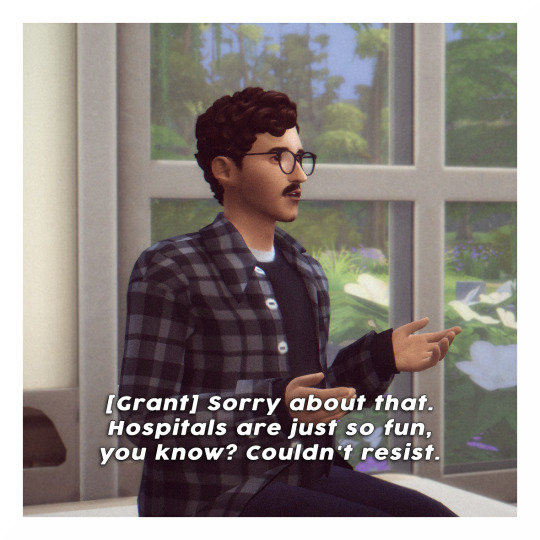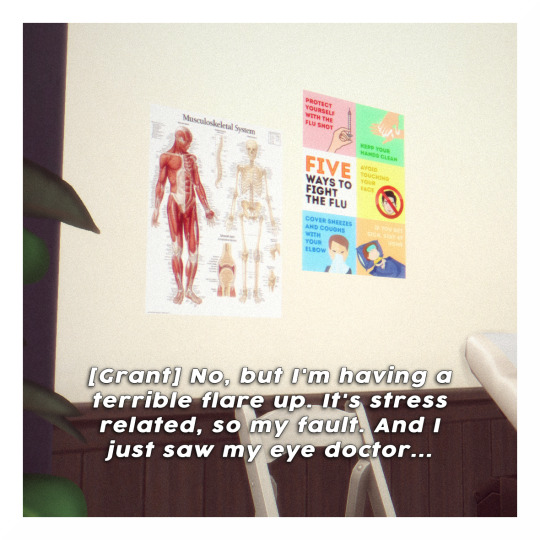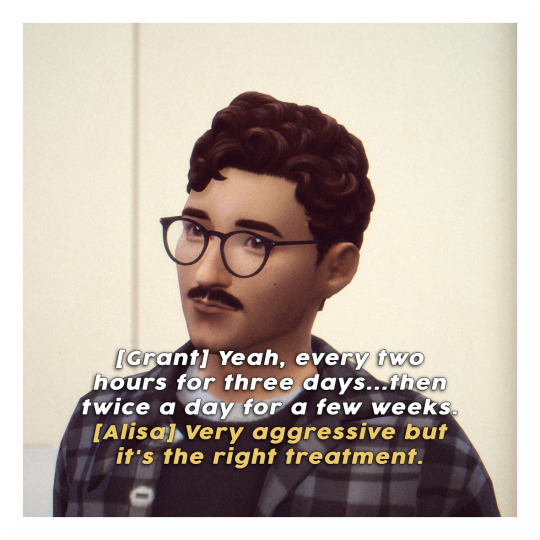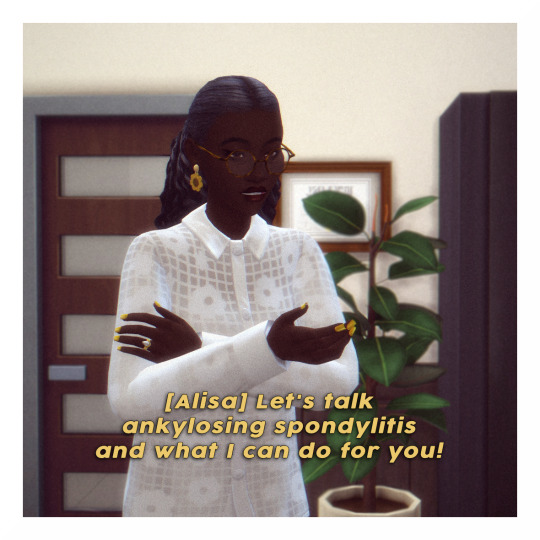#i did my research and consulted real experiences but this may not be perfectly accurate because it's fictional
Explore tagged Tumblr posts
Text









next // previous
may 18, 2021 1:00 p.m. department of rheumatology, room 414
[grant] please tell me this is a temporary flare. i really don't know if i can go back to the way things were before i got diagnosed. i'm probably being paranoid and traumatized by last year's events but...i just feel back to square one. like i can barely stand up it's so bad.
[alisa] i completely understand the concern! you finally have the keys to get things managed after having uncontrolled symptoms since you were a child. of course you don't want to lose progress. we'll get to the conversation around disease progression but i promise you i will treat this now. easiest and best way to get you feeling better in just a week or two is oral steroids. you know the drill: suppress the immune reactions and the manifestations go away.
[grant] they make me feel terrible but i'm kind of desperate and beggars can't be choosers. i'll take whatever you give me.
[alisa] temporary side effects are better than suffering unmitigated for a long time, especially since you are doing so well on a biologic. why risk letting this go on when you can treat it?
[alisa] you're also welcome to take NSAIDs like aspirin for the anti-inflammatory properties and pain relief but...
[grant] ahh, you know, i would, just...well, i don't like...um, i don't feel comfortable with pain medication.
[alisa] oh, i understand. i'm not in the business of forcing them. they are helpful for autoimmune disorders but i do know that you are, um...how do i say this?
[grant] you can tell i used to be an addict?
[alisa] well, it's not like you admitted to it on any of your paperwork, but there is a pretty curious note in your chart from a surgeon that says you completely refused any pain medication after serious invasive spinal surgery...which is...
[grant] damning evidence?
[alisa] let's just say you'd need a very strong reason to refuse in that situation.
[grant] first of all, um, i am really sorry for not being honest about it. it's just embarrassing. for the record, totally don't recommend having spinal surgery without meds because it almost killed me and that was the last time i had something this bad going on with my eyes from stress. but um, same reason i don't want over the counter stuff right now. it's not a good idea. i got into all that because i was in pain and i really don't want that to be my solution...or my death.
[alisa] oh, no, no, i absolutely respect you for sticking to your sobriety. anyway, i really shouldn't have brought it up because short-term steroids for a flare is a better solution and you're already on the best long-term treatment and that's a biologic. you know, a disease inhibitor. for you, that's humira.
[alisa] besides that, you are supposed to have yearly x-rays and bloodwork in september. keep the appointment but we'll go through all that today as well. let's see how things look internally now.
[grant] i know i kind of asked you the same question a minute ago but do you think, even if this is temporary, that it might be active disease progression?
[alisa] this is the first time you've had a flare up since starting humira, right?
[grant] uhh, yes! it is, actually. thankfully.
[alisa] then i have hope you're not getting worse and this is just connected to stress like you said. i won't make an uninformed guess about what's going on since your last x-rays were the diagnostic images when you were diagnosed last june at...oh wow, cedars sinai in los angeles. long way from home, huh?
[grant] oh, yeah. i was living and working there at the time.
[alisa] but the evidence i do have is this. you started the medication in september when you were being treated in sault ste. marie. by the time you came to see me here in january, you were already seeing some symptom relief and no flare ups. and let's see, back when you were seeking a diagnosis, you were having significant symptoms, increasingly poor quality of life, and you needed extensive surgery from herniated disks and adjacent spinal cord issues...
[alisa] outside of today, how similarly do you feel today as you did then?
[grant] i mean...things are better. a lot better. i still have pain every day and limitations but my quality of life is definitely at least good. i kind of feel more like my old self and like treatment is working.
[alisa] exactly. this being the first time you've come to see me outside of normal check-ups bodes well for you. and to be honest, for a variety of reasons, you have a very aggressive disease manifestation. to be your age, not even thirty, and to this early on in life have really extensive spinal fusion from the disease...you know what i mean? half your spine has already fused itself together. if it were progressing at the same pace, you should hypothetically feel the same or worse and you should be suffering from similar problems as last year.
[alisa] whatever is going on internally we'll see in imaging, but if it means anything to you, i am at least confident that you're doing very well, even with this current flare up. i hate that i can't reverse the damage that's already been done or ever cure you, but i feel like we're making good progress and i feel hopeful that'll prove itself through physical evidence. if it doesn't, the fact that you say you have better quality of life on a normal day is great. any improvement is a good thing.
#ts4#the sims 4#sims 4#sims 4 story#ts4 screenshots#simblr#hlcn: everything the stars promised#this is text and medical heavy so lemme know if you need more information or wikipedia links!!#disclaimer that i'm not a doctor just that i do have an autoimmune disorder and know someone with the same one as grant#i did my research and consulted real experiences but this may not be perfectly accurate because it's fictional#also i love alisa otto m.d. <3#she's so pretty and funky with her lil flower earrings and yellow nails#holocene.png#holocene.docx#hlcn: grant
28 notes
·
View notes
Photo

New Post has been published on http://simplemlmsponsoring.com/attraction-marketing-formula/social-media-marketing/are-you-really-looking-for-a-new-website/
Are You Really Looking for a New Website?


I had a great conversation with a transitioning veteran today who was eager to dive into development. He was disappointed because he was applying for junior front-end developer jobs throughout the region but walked away feeling unqualified and defeated. I encouraged him that the issue wasn’t his qualifications, the issue was confusion within our industry.
For the last two decades, I’ve sat on all sides of the online marketing wall – including consulting on and developing integrations, designing and testing user interfaces for user experience, product management to develop and prioritize product features, back-end developer, front-end developer, and even designer. Much of the frustration and confusion I see in our industry is that the terminology is vague and often the descriptions often overlap.
So you believe you’re need of a new website. Do you hire a web developer? Do you hire a web designer? Do you hire a marketing consultant? How about an SEO consultant?
Companies engage in contracts with one of the above, and then things take a turn for the worst. The frustration happens when expectations aren’t met. I’ll provide some real-world examples:
We hired a web designer. The site is beautiful, but we’re not getting any leads. We hired a developer/programmer. We spent quite a bit of money but the site is quite buggy and it’s still not implemented. We hired a marketing agency. The new site is nice but it’s really slow and we’ve lost a ton of traffic. We hired a graphic designer. Our branding is awesome but our site is horrific and we can’t figure out how to update anything. We hired an SEO consultant. We rank much better now for a multitude of industry terms, but it hasn’t led to any additional business.
Every time a company goes out to build a new web presence, the expectation should always be the same… growing their business and getting a positive return on their investment.
At times, that’s just having a highly engaging site that helps build the awareness of your brand. Sometimes the expectation is to build your personal or corporate authority in your industry. Many times, the expectation is getting more leads for your sales team. If you’re an ecommerce site, it’s more traffic driving more conversions.
Did you notice what wasn’t mentioned with those expectations?
The site is aesthetically beautiful and portrays my brand perfectly. The site is responsive and designed well for my target audience(s) to navigate and find the information they need. The site is fast and utilizes best practices for search engines to index it accurately. The site is informative, providing the content necessary to help my prospects make a purchase decision. The site is easy to use, with the flexibility to make whatever changes we may need to in the future. The site is integrated to our other systems, reducing the effort necessary to move data between sales, marketing, support, and other systems. The site is optimized for social media, empowering my advocates to easily share information in well-formatted updates. The site is performing well as part of our overall digital marketing efforts. Our reporting and dashboards we get are helping us continuously optimize and improve our offerings.
All of these goals aren’t often discussed in meetings with your [insert title here], but they should be. The problem is that the market place for talent is often fractured. The clients that I work with have often spent hundreds of thousands of dollars between internal manpower and external resources… and never met the goals above.
If you hire a developer or programmer, the expectation of that developer is often that they’re going to start with a blank editor and write every line of code you’ve requested. That’s insanity nowadays. I have literally tossed code that took years to develop and hundreds of thousands of dollars for solutions that cost hundreds of dollars. I’m not blaming the programmer for this, they’re doing what programmers do. The problem is the gap in expectations.
If you hire a designer, your site may be aesthetically stunning. But they also may hard-code elements making it impossible to make edits. They may use uncompressed imagery, causing the site to load slow. And they may not actually integrate it to a solution for lead capture. I once had a client contact me months after their new, beautiful site was live. They couldn’t understand why it wasn’t generating any leads and hired me to help out. Within minutes, I found that the form they had was purely aesthetic and didn’t actually submit the data anywhere. They may have had hundreds of leads… but they never had any way to find out. The design agency met their expectations… but not the businesses.
More often than not, I see sites sold as projects. As a result, the agency, designer, or developer is financially rewarded for delivering a site that takes every shortcut possible to save time and make a better profit on the engagement. And, of course, the project goes to the lowest (or next to lowest bidder). Companies sometimes chuckle that they had someone quote a twenty-five thousand dollar site and they were able to get theirs built for a few thousand dollars. I follow up asking how it’s performed for their business and the response is often… oh, we get most of our business by word of mouth.
Well duh. Your cheap site sucks. You threw money away. Had you invested the $25,000, you may have doubled the growth of your business depending on the capabilities of the resource you were going to hire.
Hiring a marketing resource who understands your business needs and can research the audience and goals you’re trying to attain is a much better investment. An individual or organization who understands content, research, design, development, integration, analytics, the landscape of tools and platforms, integration, as well as trends in social, search, mobile, advertising, video, et cetera… can move the needle forward for your online marketing needs.
But that’s often neither a designer nor a developer.
My advice to this veteran? He was honorably discharged so we know he has good character and work ethic. He traveled extensively throughout the world during and after his enlistment, so he has a great business acumen and experience no one else has. He was an outstanding and engaging communicator, I enjoyed my time speaking with him.
He admitted that he didn’t think he could sit in front of a screen all day writing code so I advised him to abandon his goal of becoming a developer. That’s not to say I advised him to abandon development, I think he should pursue building expertise there. I do a ton of development, but it’s never the expectation of my clients. They want business results, not code.
By developing a wide array of knowledge and expertise in my industry, I often push my clients to buy versus build. I often have them abandon projects that are money pits. And I work to prioritize their investment where it’s going to attain the highest ROI.
I don’t build web sites for my clients, I build business results using many assets… including a web site.
Download a Sponsored Marketing Whitepaper: Health and Beauty Brands in the Engagement Economy – How to Preserve the Human Touch on Digital Channels
While consumers gravitate towards the digital space, they still crave the personal, human experiences they’re used to in stores. Download Now
The post Are You Really Looking for a New Website? appeared first on MarTech.
Read more: tracking.feedpress.it
0 notes
Text
Four Ways to Use Science to Get the Best Results for Your Clients
Let’s say you want to create a fitness and nutrition plan to help a new client get the best possible results. (A typical workday, in other words.) What do you base that plan on?
A. The best scientific evidence—randomized double-blind placebo-controlled trials are my jam!
B. Methods I’ve used before and seen work. Real-life results trump the lab any day.
If you pick A, your plan may be too rigid for the demands and challenges of everyday life. Go with B, and your advice may be outdated.
So which option is better? Trick question. There is no better. The only good answer is both.
That’s what “evidence-based training” is all about—integrating your personal judgment based on experience with the best scientific studies. Either one alone can be limiting. But using both empowers you to seek new solutions.
My thinking is inspired by the work of David Sackett, MD, known as the father of evidence-based medicine. Based on his ideas, I’ve found four ways to make the most of this approach.
READ ALSO: “Should Trainers Care About Evidence-Based Training and Therapy?”
1. Keep up on the latest science
Science is always evolving. New discoveries are made; old findings are debunked. Staying on top of it gives you more options. You never know when one of them will come in handy.
Take my client John. (All names have been changed to protect privacy.) He came to me with the goal of building muscle, something he’d been trying to do on his own for many years. But because of an accident two decades earlier, lower-body training caused excruciating knee pain that lasted for days. Naturally, he’d learned to avoid it.
As it happens, I was familiar with occlusion training, a simple lifting technique that involves tying wraps around your limbs to restrict blood flow. Studies show increases in muscle growth with occlusion, even when using surprisingly light loads. Once we cleared it with his doctor, John was finally able to train his legs with little to no knee discomfort the following day.
Had I not been aware of the studies on occlusion training, I likely would’ve tried to build muscle the traditional way, using relatively heavy loads and high volume, which would’ve done nothing but cause him a lot of unnecessary pain.
It’s easy for me to tell you to spend more time reading and analyzing scientific studies. (You know, in all your free time.) You can make it easy on yourself by subscribing to a research review like MASS or Weightology. Certifications are another way to immerse yourself in exercise or nutrition science, although it can take a long time for new research to find its way into official textbooks and courses.
READ ALSO: “A Trainer’s Guide to Building Muscle”
2. Let go of personal bias
We all process information through the filters of our personal experiences and beliefs. Taken to the extreme, these biases can narrow our focus to the point that we only pay attention to information that confirms what we already think is true, while ignoring anything that might challenge those ideas and practices.
A good trainer learns to recognize her own bias and consider other lines of thought. Instead of becoming comfortable with the status quo, she learns to challenge it. This is how trainers develop their expertise.
Rookie trainers tend to focus on a single methodology of coaching. (I know I did.) One trainer might be interested in athletic performance, so he trains all his clients like competitive athletes. Another might subscribe to the keto diet, so she coaches others to do the same.
I have one client, Sarah, who approached me with a straightforward weight-loss goal. She was young and healthy, so I put her on the same program I use for a lot of my clients: circuits and superset-style workouts to elevate her heart rate. Plenty of research backs up this type of training, and I knew from experience that it works.
But a few months later Sarah was diagnosed with a benign condition called postural orthostatic tachycardia syndrome (POTS). Symptoms include a rapid increase in heartbeat upon standing. Sarah’s heart would race when switching rapidly between moves, and it caused her a lot of anxiety.
We switched to a program emphasizing heavier lifts, with low reps and more rest between sets. The extra recovery time between movements helped her feel more in control.
I’d only used this type of training for clients with serious strength goals. I never would’ve considered it for a fat-loss client. But it was the right choice for Sarah, helping her build confidence while adjusting to the new reality of her diagnosis. It only worked because I was open to trying something new.
READ ALSO: “Stop Training Your Clients Like CrossFitters, Bodybuilders, or Powerlifters”
3. Get to know your client
It’s one thing to have a fully loaded toolbelt, with a mastery of both traditional and new training protocols, all backed by research and practice. But you still need to know how to pick the right tool for the job. That means always factoring in the client’s abilities and limitations, as we just showed, as well as his personal preferences and lifestyle. After all, it doesn’t matter how effective a plan can be if the client can’t or won’t follow it.
What do you know about the client’s job, family life, social activities, sources of stress and anxiety? Does she travel a lot? A workout plan requiring special equipment won’t work. Does she hate doing burpees? Don’t make them an integral part of her program.
Consider Mike, an ER doctor who routinely works 12- to 16-hour shifts. He rarely has time for a sit-down meal at work, and instead fuels himself throughout the day with pizza and vending machine snacks. You can imagine how that affects his ability to lose fat.
Interestingly, he told me that with the stress of the job, he wasn’t all that hungry at work. So I asked Mike if he’d consider modified fasting. He could consume all his calories either before or after his shift, and ignore food entirely while on the job.
There’s no magic to intermittent fasting. It can be a perfectly good way to eat less overall, but in head-to-head studies it isn’t more effective than traditional plans. But it turned out to be the best approach for Mike, allowing him to avoid hospital junk food and achieve a calorie deficit.
So how do you figure out which tool will work for your client? Try this new scientific breakthrough: Ask.
Start with questions like these at your initial consultation:
What are your biggest priorities in life?
Of diets you’ve tried in the past, what did you like and what didn’t you like?
Are you satisfied with just a few bites of dessert, or do you inevitably eat more than you planned?
When you’re on the same page from the beginning, you can suggest a plan that’s realistic for the client’s lifestyle, rather than wasting everyone’s time on strategies that aren’t likely to work.
READ ALSO: “Five Ways to Help Your Clients Lose Weight”
4. Embrace trial and error
Whether you’re a trainer or a scientist, you won’t get far without occasional failure. You won’t learn anything if you never make a mistake or hit a dead end. Failure, on the other hand, gives you a chance to reevaluate, modify, and try something else, this time with more insight into what doesn’t work.
Think of you and your client as a scientific team: You’re monitoring performance, tracking compliance, and seeing what works best. It’s all data, and you’re gathering it together.
One client, Stephanie, is a busy mother with two young children and a demanding job at a large corporation. She regularly opted for convenience food, which was taking a toll.
Her goals were to drop some weight and boost her energy. She seemed like a good candidate for intermittent fasting, which worked so well for Mike. It would free up time early in the day so she could focus on getting the kids off to school and having a productive morning at work. By early afternoon, she could opt for something sensible for her first meal of the day. Even if it wasn’t sensible, I figured a few extra calories would be more than balanced out by eating fewer meals.
But we soon realized it wasn’t working at all. Waiting until midday was giving Stephanie license to eat whatever she wanted. Even if she wasn’t ravenous (which she sometimes was), she convinced herself she had tons of calories banked and could splurge almost daily.
We changed to a more traditional meal frequency, with an emphasis on healthy, easy-to-prepare foods that she could prep ahead of time.
That story illustrates as well as anything what we mean when we talk about evidence-based training. It isn’t about closing off options; it’s about opening them up. If a method is safe and you have good reason to believe it might work, give it a shot.
Just keep in mind that if it works for one client, that means … it works for one client. Fitness and nutrition are too individualized for anything to work for everyone.
He Said, She Said: Download Our FREE Guide to Analyzing Fitness Research
It’s become commonplace to use cherry-picked, biased and misinterpreted research to back up personal training promises and marketing. Don’t be that fit pro.
Enter your email below for our free guide by Dr. Jonathan Fass, PT, DPT, CSCS. Whether it’s CrossFit or vaccines, Dr. Fass will guide you on how to accurately analyze fitness research so you can better inform your clients.
Get your guide here:
The post Four Ways to Use Science to Get the Best Results for Your Clients appeared first on The PTDC.
Four Ways to Use Science to Get the Best Results for Your Clients published first on https://medium.com/@MyDietArea
0 notes
Text
Four Ways to Use Science to Get the Best Results for Your Clients
Let’s say you want to create a fitness and nutrition plan to help a new client get the best possible results. (A typical workday, in other words.) What do you base that plan on?
A. The best scientific evidence—randomized double-blind placebo-controlled trials are my jam!
B. Methods I’ve used before and seen work. Real-life results trump the lab any day.
If you pick A, your plan may be too rigid for the demands and challenges of everyday life. Go with B, and your advice may be outdated.
So which option is better? Trick question. There is no better. The only good answer is both.
That’s what “evidence-based training” is all about—integrating your personal judgment based on experience with the best scientific studies. Either one alone can be limiting. But using both empowers you to seek new solutions.
My thinking is inspired by the work of David Sackett, MD, known as the father of evidence-based medicine. Based on his ideas, I’ve found four ways to make the most of this approach.
READ ALSO: “Should Trainers Care About Evidence-Based Training and Therapy?”
1. Keep up on the latest science
Science is always evolving. New discoveries are made; old findings are debunked. Staying on top of it gives you more options. You never know when one of them will come in handy.
Take my client John. (All names have been changed to protect privacy.) He came to me with the goal of building muscle, something he’d been trying to do on his own for many years. But because of an accident two decades earlier, lower-body training caused excruciating knee pain that lasted for days. Naturally, he’d learned to avoid it.
As it happens, I was familiar with occlusion training, a simple lifting technique that involves tying wraps around your limbs to restrict blood flow. Studies show increases in muscle growth with occlusion, even when using surprisingly light loads. Once we cleared it with his doctor, John was finally able to train his legs with little to no knee discomfort the following day.
Had I not been aware of the studies on occlusion training, I likely would’ve tried to build muscle the traditional way, using relatively heavy loads and high volume, which would’ve done nothing but cause him a lot of unnecessary pain.
It’s easy for me to tell you to spend more time reading and analyzing scientific studies. (You know, in all your free time.) You can make it easy on yourself by subscribing to a research review like MASS or Weightology. Certifications are another way to immerse yourself in exercise or nutrition science, although it can take a long time for new research to find its way into official textbooks and courses.
READ ALSO: “A Trainer’s Guide to Building Muscle”
2. Let go of personal bias
We all process information through the filters of our personal experiences and beliefs. Taken to the extreme, these biases can narrow our focus to the point that we only pay attention to information that confirms what we already think is true, while ignoring anything that might challenge those ideas and practices.
A good trainer learns to recognize her own bias and consider other lines of thought. Instead of becoming comfortable with the status quo, she learns to challenge it. This is how trainers develop their expertise.
Rookie trainers tend to focus on a single methodology of coaching. (I know I did.) One trainer might be interested in athletic performance, so he trains all his clients like competitive athletes. Another might subscribe to the keto diet, so she coaches others to do the same.
I have one client, Sarah, who approached me with a straightforward weight-loss goal. She was young and healthy, so I put her on the same program I use for a lot of my clients: circuits and superset-style workouts to elevate her heart rate. Plenty of research backs up this type of training, and I knew from experience that it works.
But a few months later Sarah was diagnosed with a benign condition called postural orthostatic tachycardia syndrome (POTS). Symptoms include a rapid increase in heartbeat upon standing. Sarah’s heart would race when switching rapidly between moves, and it caused her a lot of anxiety.
We switched to a program emphasizing heavier lifts, with low reps and more rest between sets. The extra recovery time between movements helped her feel more in control.
I’d only used this type of training for clients with serious strength goals. I never would’ve considered it for a fat-loss client. But it was the right choice for Sarah, helping her build confidence while adjusting to the new reality of her diagnosis. It only worked because I was open to trying something new.
READ ALSO: “Stop Training Your Clients Like CrossFitters, Bodybuilders, or Powerlifters”
3. Get to know your client
It’s one thing to have a fully loaded toolbelt, with a mastery of both traditional and new training protocols, all backed by research and practice. But you still need to know how to pick the right tool for the job. That means always factoring in the client’s abilities and limitations, as we just showed, as well as his personal preferences and lifestyle. After all, it doesn’t matter how effective a plan can be if the client can’t or won’t follow it.
What do you know about the client’s job, family life, social activities, sources of stress and anxiety? Does she travel a lot? A workout plan requiring special equipment won’t work. Does she hate doing burpees? Don’t make them an integral part of her program.
Consider Mike, an ER doctor who routinely works 12- to 16-hour shifts. He rarely has time for a sit-down meal at work, and instead fuels himself throughout the day with pizza and vending machine snacks. You can imagine how that affects his ability to lose fat.
Interestingly, he told me that with the stress of the job, he wasn’t all that hungry at work. So I asked Mike if he’d consider modified fasting. He could consume all his calories either before or after his shift, and ignore food entirely while on the job.
There’s no magic to intermittent fasting. It can be a perfectly good way to eat less overall, but in head-to-head studies it isn’t more effective than traditional plans. But it turned out to be the best approach for Mike, allowing him to avoid hospital junk food and achieve a calorie deficit.
So how do you figure out which tool will work for your client? Try this new scientific breakthrough: Ask.
Start with questions like these at your initial consultation:
What are your biggest priorities in life?
Of diets you’ve tried in the past, what did you like and what didn’t you like?
Are you satisfied with just a few bites of dessert, or do you inevitably eat more than you planned?
When you’re on the same page from the beginning, you can suggest a plan that’s realistic for the client’s lifestyle, rather than wasting everyone’s time on strategies that aren’t likely to work.
READ ALSO: “Five Ways to Help Your Clients Lose Weight”
4. Embrace trial and error
Whether you’re a trainer or a scientist, you won’t get far without occasional failure. You won’t learn anything if you never make a mistake or hit a dead end. Failure, on the other hand, gives you a chance to reevaluate, modify, and try something else, this time with more insight into what doesn’t work.
Think of you and your client as a scientific team: You’re monitoring performance, tracking compliance, and seeing what works best. It’s all data, and you’re gathering it together.
One client, Stephanie, is a busy mother with two young children and a demanding job at a large corporation. She regularly opted for convenience food, which was taking a toll.
Her goals were to drop some weight and boost her energy. She seemed like a good candidate for intermittent fasting, which worked so well for Mike. It would free up time early in the day so she could focus on getting the kids off to school and having a productive morning at work. By early afternoon, she could opt for something sensible for her first meal of the day. Even if it wasn’t sensible, I figured a few extra calories would be more than balanced out by eating fewer meals.
But we soon realized it wasn’t working at all. Waiting until midday was giving Stephanie license to eat whatever she wanted. Even if she wasn’t ravenous (which she sometimes was), she convinced herself she had tons of calories banked and could splurge almost daily.
We changed to a more traditional meal frequency, with an emphasis on healthy, easy-to-prepare foods that she could prep ahead of time.
That story illustrates as well as anything what we mean when we talk about evidence-based training. It isn’t about closing off options; it’s about opening them up. If a method is safe and you have good reason to believe it might work, give it a shot.
Just keep in mind that if it works for one client, that means … it works for one client. Fitness and nutrition are too individualized for anything to work for everyone.
He Said, She Said: Download Our FREE Guide to Analyzing Fitness Research
It’s become commonplace to use cherry-picked, biased and misinterpreted research to back up personal training promises and marketing. Don’t be that fit pro.
Enter your email below for our free guide by Dr. Jonathan Fass, PT, DPT, CSCS. Whether it’s CrossFit or vaccines, Dr. Fass will guide you on how to accurately analyze fitness research so you can better inform your clients.
Get your guide here:
The post Four Ways to Use Science to Get the Best Results for Your Clients appeared first on The PTDC.
Four Ways to Use Science to Get the Best Results for Your Clients published first on https://onezeroonesarms.tumblr.com/
0 notes